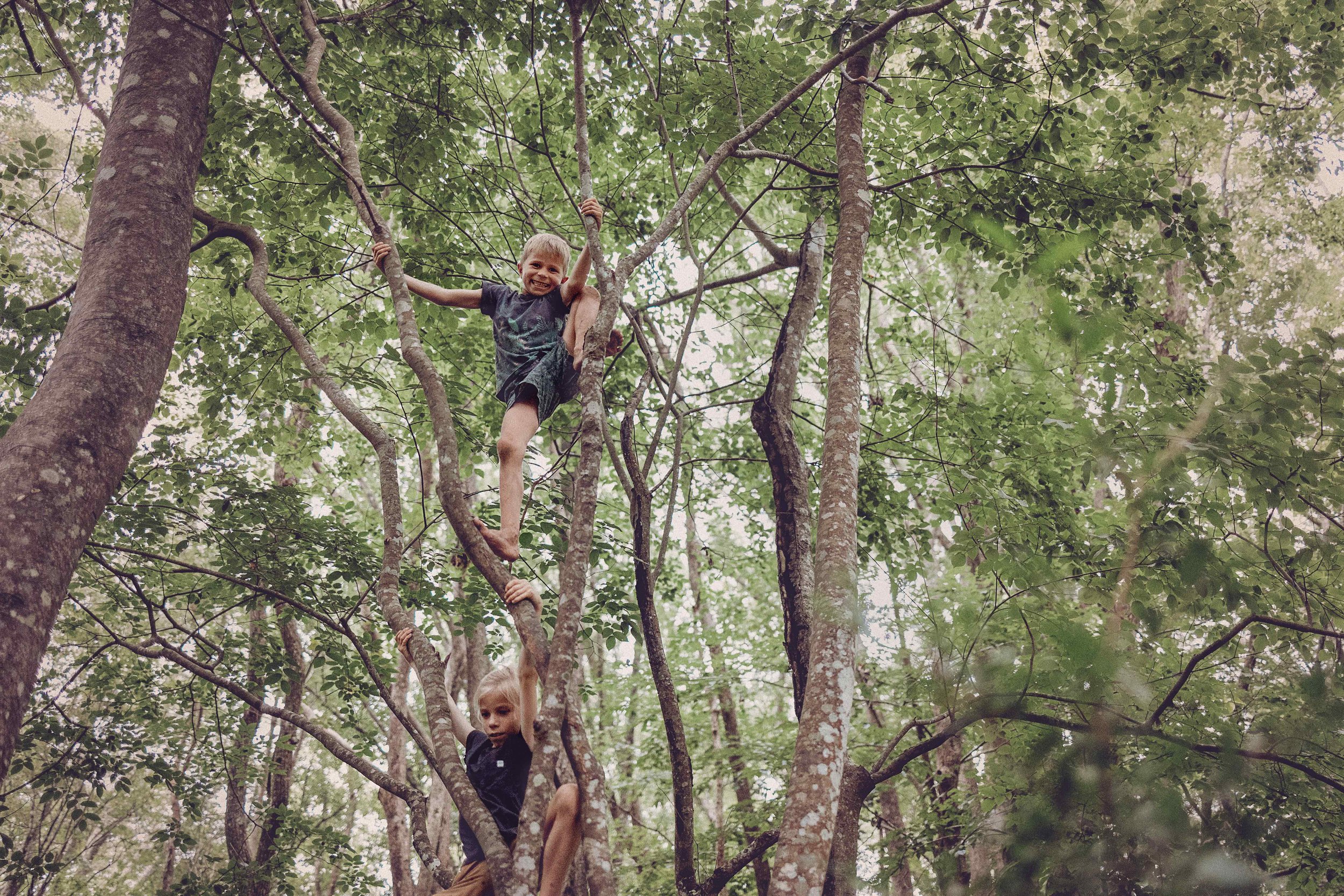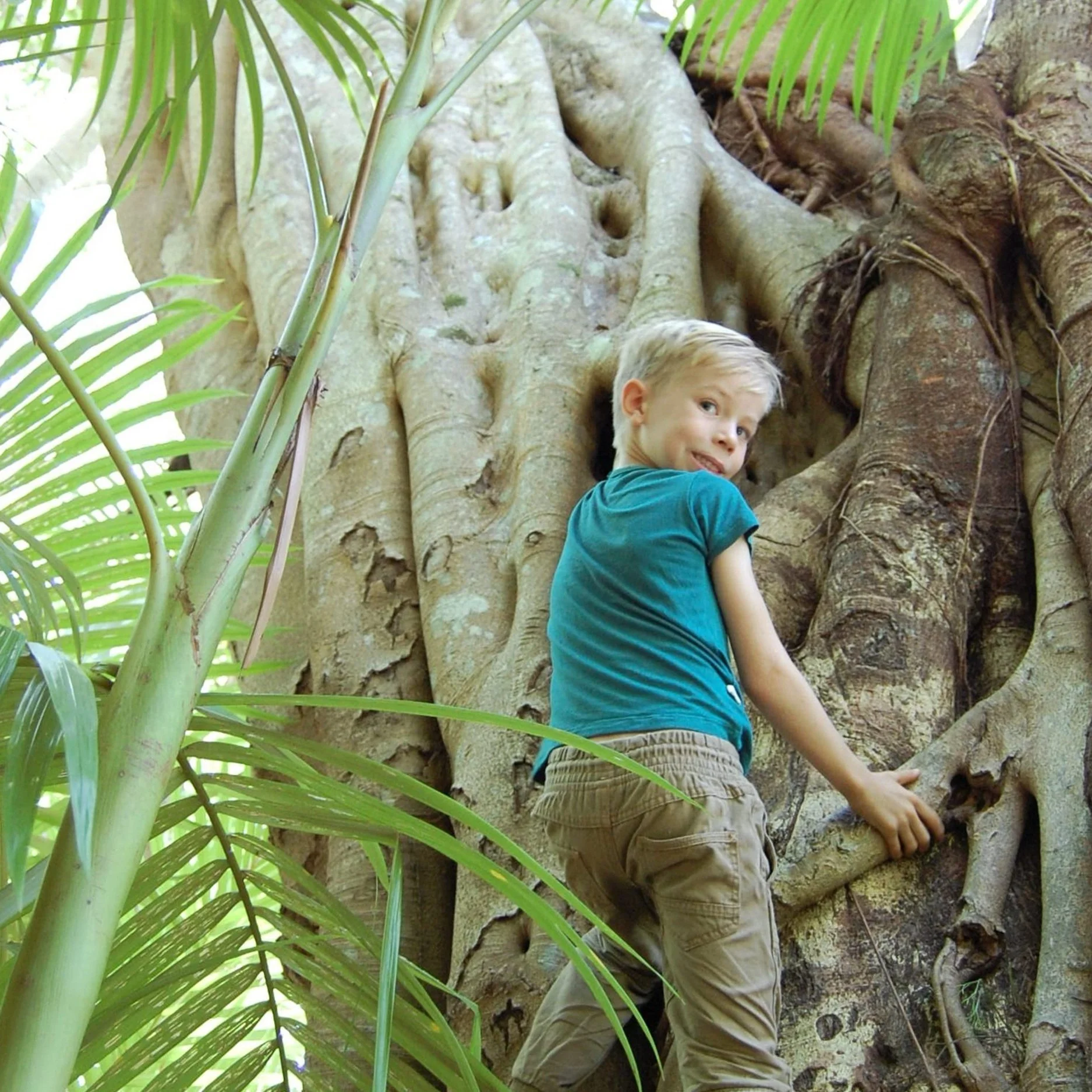OUT ON A LIMB - Your Complete Guide to Risky Play at Heights
Got a climber on your hands? Read our top tips for teaching kids to tree climb, and the risks and benefits of playing at great heights.
In this series of blogs, we’ll be diving deeper into Ellen Sandseter’s 6 categories of risky play.
These are:
1. Play with great HEIGHTS
2. Play with high SPEED
3. Play with dangerous TOOLS
4. Play near dangerous ELEMENTS (read more here and here)
5. ROUGH‐AND‐TUMBLE play
6. Play where the children can ‘DISAPPEAR’/GET LOST.
There are countless benefits of risky play for children (read more here), and we are massive advocates for allowing children to have supervised opportunities to engage with risk.
Today, we’re focusing on one of the most common types of risky play that children love: CLIMBING.
PLAY WITH GREAT HEIGHTS
In her research, Sandseter found that “If there was anything around that could be climbed, the children would immediately begin climbing it.” This included trees, playground climbers, big rocks, steep slopes, hillsides or anything else they could pull themselves up on.
At Wildlings, we often observe children take to climbing activities, whether that be balancing on logs, climbing up steep banks by gripping onto tree roots, slipping their way up the mudslide, or reaching for handholds to climb up Grandma Fig.
These activities are usually accompanied by gleeful giggles and proud calls of accomplishment from the top.
But what goes up, must come down!
Sandseter found that the other type of risky play associated with heights was – you guessed it – falling or jumping down from high places.
“Jumping down from high places is a way of ‘losing control’, letting go and just allowing yourself to fall more or less uncontrolled, and hoping that hitting the ground will not be too unpleasant.”
Do you remember that feeling?
I can see a whole reel of kids in my mind’s eye, falling, sliding, and jumping down from heights with a mixture of trepidation and wild abandon.
They land, and we watch, unsure which way their reaction will go.
Sometimes they check themselves, a little scratch, a bruise, a little tenderness. Not so bad. Then they look around, and you can see it spreading through their body. “Again!” they cry, as they head back up for another go.
HAZARD VS RISK
As always when we’re talking about risky play, it’s important to distinguish between hazards and managed risks.
Early Childhood Researcher Alison Stephenson explains taking a risk as involving a challenging experience, where safety is balanced against the challenge and there is no likelihood of serious injury. A hazard, on the other hand, alludes to a dangerous situation where there is potential for serious or fatal injuries.
Play Advocate Cheryl Greenfield draws an alternative distinction, where hazard is seen as something a child is not aware of, while a risk is when the child is uncertain “about being able to achieve the desired outcome, requiring a choice whether to take the risk or not”.
Here are some questions we ask ourselves, and children, when they engage in climbing play:
Where are they going to land if they fall?
Is it in water, if so, is it shallow or deep?
Is the ground soft underneath, or are there lots of rocks or roots?
Will they fall on a flat surface or does it drop off steeply?
Will they fall on other children?
How many kids can we safely manage at this height?
If they change their mind, can they get down the way they got up?
When in doubt, we return to the wise words
of
Peter Gray:
“Play, to be safe, must be free play, not coerced, mAnaged, or pushed by adults.”
Climbing and falling are activities that require children to tune into their bodies and make decisions that feel good for them, without comparing themselves to other people’s abilities.
For example: a child wants to engage in a climbing activity, but we can clearly see that they want to climb higher or take a bigger risk than we know is good for them.
We can step in and make the activity happen, but it might actually be too challenging for them. We’ve now placed them beyond their limit, and they don’t trust their ability to get around easily. They are now in a riskier position than if they’d waited until they could initiate the activity themselves.
In these moments, we can come down to their level and talk to them about it, acknowledge their dream and desire to climb that tree or do that activity, and assure them that even though at this time that activity is beyond their reach, there will be a time when they’ll be able to do it, and it will feel really good.
We can help them to their edge each time, assuring them that we’re there supporting their every move, and it might take several attempts, weeks or months until that next step is possible, but one day it will happen.
And before we know it, they are doing the very thing they thought they couldn’T...
and we’re waving up at them At a great height, marvelling at their strength and determination.
OUT ON A LIMB
Ah, the joy of climbing trees. To travel up through their sprawling limbs and stand far above the ground, seeing the world from a bird’s-eye view – there’s a real magic to it.
But it can be a challenging thing to sit back and watch our children begin to climb, knowing the risk of injury gets higher the further they go.
Tree climbing is a skill and there are ways we can support this activity to make it safer for all involved.
So we’ve sent our roots out to gather the best tips on how to get started climbing trees.
Here they are:
Wait until your child shows that they are ready to climb a tree, and encourage kids to go at their own pace. Never push, force, or coax a child to climb a tree.
Start with small healthy trees with stiff limbs that are easy to climb. Make sure the tree branches do not bend under the child’s weight.
Support and guide your child. Once they gain a little confidence, you can allow your child to do it independently as he or she gains mastery.
Hands and arms are for grabbing, guiding, and reaching for tree limbs, while feet and legs are for pushing and climbing.
Encourage your child always to have at least one “stronghold.” In other words, always have one hand or foot positioned in a way that helps your child feel safe and secure in the tree. OR run with the rule of three - maintain three points of contact with the tree as they move around.
Teach your children not to move or climb higher unless they feel safe and secure in the tree.
Practice descending the tree or climbing down before climbing higher. Descending and getting down from a tree is often harder than climbing up!
Get out of the way and allow children to find mastery. There comes a point when every parent needs to trust their child to do it on their own. Step back and bask in the development of your child’s growing self-confidence as they master vertical climbs.
Whenever you feel unsafe about your child, calmly ask, “Do you feel safe?” Help if needed. (This is a wonderful alternative to “Be careful”. For more tips on what to say during risky play, check out our free downloadable.)
Consider using a helmet (or gloves if the bark is rough) the first few times they climb trees.
BENEFITS OF TREE CLIMBING
Not only do kids get a massive hit of self-esteem from being able to say “I did it!”, but it also encourages them to problem-solve and figure out their path up the tree like a puzzle, while building resilience and a “can do” attitude.
Tree climbing is an excellent opportunity for kids to grow and learn, with benefits such as:
self-confidence
focus
concentration
hand-eye coordination
flexibility
spatial reasoning
physical strength
mental strength
gross motor abilities
new neural pathways in the brain
emotional intelligence
cognitive skills
memory
Furthermore, John Gathright, from Tree Climbing Japan, has found that there are significant emotional benefits to tree climbing as well.
From being the first person to support a paraplegic to climb one of the tallest trees in the world, Gathright spawned a movement across Japan of helping disabled children to experience the wonder of tree climbing.
Throughout this process, he researched the physiological and emotional impact of this activity, and the trees themselves, on the children.
The transformation in the children was remarkable, “We found that vitality and the positive emotions increased, but negative emotions decreased.”
His findings confirm what we have always suspected to be true – trees heal us.
Gathright found that tree climbing lowered stress hormones and positively impacted children’s pain sensitivity, leading him to conclude that the trees had a masking effect.
Having initiated several programs now to support children recovering from abuse and living with disabilities, he has this to say about the magic of trees:
“Trees are our friends because they will never leave us or abandon us. They are always there with their limbs wide open waiting for us, to comfort us and help us. They’re our teachers because they live their life to give. They are full of charity and kindness. They are wonderful examples of how we can be kind and how we can dream big. And [they are] doctors, because they can help us heal sad and lonely hearts.”
UP, UP AND AWAY…
Tree climbing is just one of the ways children can explore risky play at heights, but there are so many more – the sky is the limit!
As with all play, there is always a chance a child could get hurt. But does that mean that we should prevent their play, or stop them from seeing how far they can go before they meet their edge?
Perhaps they can reach much greater heights than we could possibly imagine - if we let them try.
We hope that this guide has given you a better understanding of what it means to explore risky play at great heights.
If you have a story about playing at heights or want to find more ways to explore risky play with your own children, we’d love to hear from you via our socials @wildlings_forestschool.
Written by Ellen Nesbitt. Ellen is a nature play advocate and creative writer with a passion for helping families connect with the outdoors. She is dedicated to exploring ways to nurture children's creativity, independence, wellbeing and love for nature.


